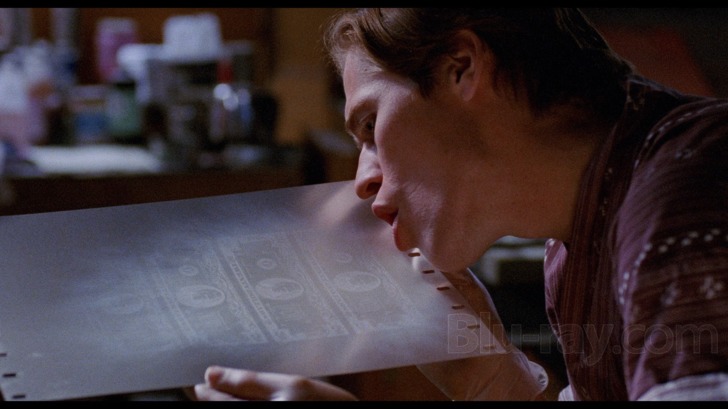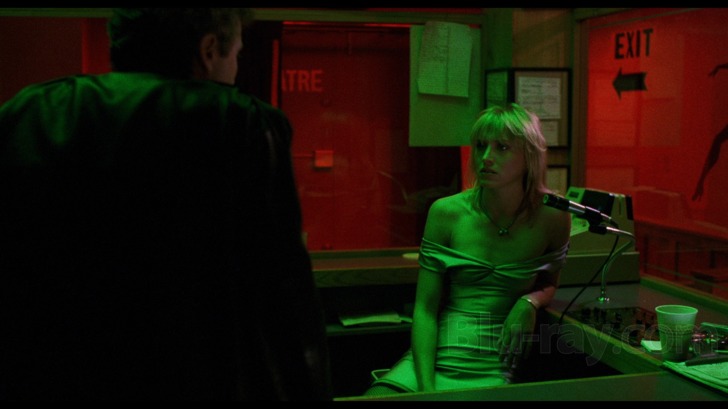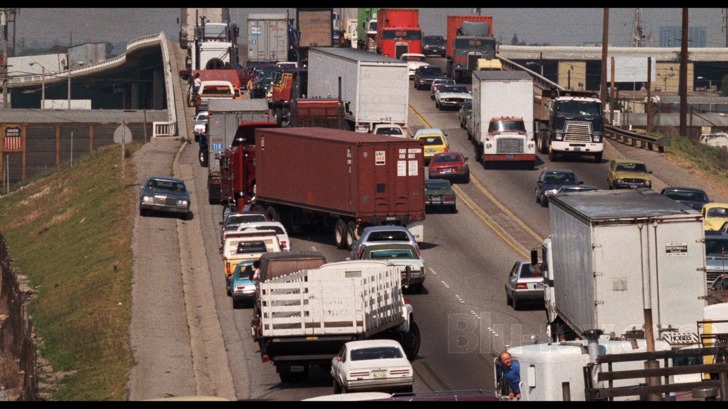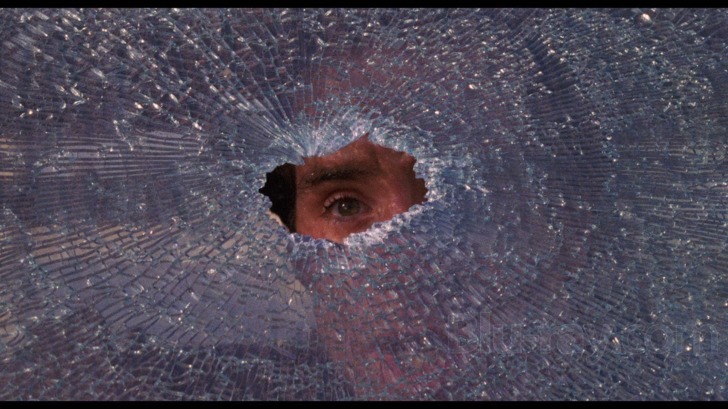To Live and Die in L.A. Blu-ray Movie
HomeTo Live and Die in L.A. Blu-ray Movie 
Remastered / Blu-ray + DVDArrow | 1985 | 116 min | Rated BBFC: 18 | Nov 21, 2016

Movie rating
7.8 | / 10 |
Blu-ray rating
| Users | 4.5 | |
| Reviewer | 4.0 | |
| Overall | 4.0 |
Overview
To Live and Die in L.A. (1985)
When his partner is murdered just days before retirement, Secret Service Agent begins an obsessive hunt for the killer counterfeiter and all-round psychopath.
Starring: William Petersen, Willem Dafoe, John Pankow, Debra Feuer, John TurturroDirector: William Friedkin
| Drama | Uncertain |
| Crime | Uncertain |
| Film-Noir | Uncertain |
| Thriller | Uncertain |
| Action | Uncertain |
Specifications
Video
Video codec: MPEG-4 AVC
Video resolution: 1080p
Aspect ratio: 1.85:1
Original aspect ratio: 1.85:1
Audio
English: DTS-HD Master Audio 5.1 (48kHz, 24-bit)
English: LPCM 2.0 (48kHz, 24-bit)
Subtitles
English SDH
Discs
Blu-ray Disc
Two-disc set (1 BD, 1 DVD)
DVD copy
Playback
Region B (locked)
Review
Rating summary
| Movie | 3.5 | |
| Video | 4.5 | |
| Audio | 4.0 | |
| Extras | 4.0 | |
| Overall | 4.0 |
To Live and Die in L.A. Blu-ray Movie Review
Reviewed by Jeffrey Kauffman November 24, 2016Has a song ever gotten you into a movie theater to see a film you might not have otherwise rushed to view? It’s happened a grand total of two times for me in my adult life, and the first of those was a case where I hadn’t even heard the song yet. In 1983, I walked by a neighborhood theater in southeast Portland and for some reason stopped to look at the poster for Never Say Never Again, and flew my geek flag high when I became excited to see that according to the credits the theme song was reuniting two people from one of my favorite bands growing up, Brasil '66, vocalist Lani Hall, and her former boss Sergio Mendes. Suffice it to say that the song itself turned out to be no great hit (though I apparently like it more than many Bond fans, some of whom have gone to great lengths to rate all of the Bond themes, with this one coming in near the bottom), but it did account for at least one ticket sale here in the Pacific Northwest. A couple of years later I was happily ensconced with my first cable box and it was an era where MTV actually played music videos (imagine!), and I became quite enamored of Wang Chung’s theme for To Live and Die in L.A., a tune which seemed to suggest some unexpected depth from a band I had known previously only through the relatively lightweight Dance Hall Days. This song, like Never Say Never Again, failed to register very dramatically on the charts, but it again accounted for at least one ticket sale to the actual film, though in this case it accounted for that sale due to it actually having been heard instead of the “marquee value” of the talent involved piquing enough interest to get a keister into a theater seat. That theme music, along with the rest of Wang Chung’s score for the film, may anchor this entry squarely in its mid-eighties milieu, but in other ways To Live and Die in L.A. is a callback of sorts to some of director William Friedkin’s earlier efforts, notably The French Connection (also available in this edition). The film can’t quite overcome some of its clichés, but it has a palpable mood, good performances and a couple of exciting set pieces, not to mention “that” music.

Since my hunch is most coming to this review are going to be more interested in a comparison of this edition’s video, audio and supplements to the old MGM release, for those wanting a plot recap, I refer you my colleague Casey Broadwater’s To Live and Die in L.A. Blu-ray review of that edition.
See the video section below for information on the joint release of this title by different labels for the US and UK markets.
To Live and Die in L.A. Blu-ray Movie, Video Quality 

Note: The video section of this review is just a little different than most due to the fact that To Live and Die in L.A. has been released
simultaneously in the United States by Shout! Factory and in the United Kingdom by Arrow Video. I have tried to come close to recreating Casey's
screenshots from the old MGM To Live and Die in L.A. Blu-
ray
review for the first ten screenshots (excluding number 9, which was a screenshot of the MGM menu) of both the US Shout! To Live and Die in L.A. Blu-ray review and the UK Arrow
To Live and Die in L.A. Blu-ray review. Similarly, I've
attempted to come close to duplicating screenshot 9 as well as 11-19 on the new US and UK releases. What I recommend for all those interested in
any
of these releases, but of course especially the two new ones, is to simply open full sized windows in separate tabs and do a personal contrast and
compare.
My comments below will give my reactions to the similarities and differences between the Shout! and Arrow releases.
Note 2: As is their custom, Arrow provided a check disc for review purposes which I am assuming is identical to the retail final. Unfortunately
I've not yet been provided with a PDF copy of their booklet, which I assume probably has detailed information about the transfer. If/when that data is
forthcoming, I'll update this review with a quote from the booklet.
Both the Shout and Arrow releases present To Live and Die in L.A. with an AVC encoded 1080p transfer in 1.85:1, sourced off of a new 4K
scan of the original camera negative supervised and approved by director William Friedkin. A cursory comparison of both of these releases to the old
MGM release shows that in virtually every area videophiles tend to be concerned with, the new releases offer better accountings of the palette, detail
and grain resolution (though there's a bit of variability here, discussed below). Casey mentioned a lack of fine detail and some inconsistent blacks in his
review of the MGM version, but both the Shout and Arrow releases boast very good fine detail in at least the more brightly lit moments (and especially
in close-ups, as should be expected), and blacks are solid and convincing throughout both presentations. Clarity and sharpness are generally excellent,
and while Casey mentioned some crushing in dark scenes, I found shadow definition and delineation to be convincing and organic looking in both of the
new versions.
There are some moments in both presentations where image quality is just slightly degraded looking, with a coarser grainfield and somewhat browner,
less appealing, palette. Look at screenshots 16-19 for examples. What's apparent in comparing the Arrow and Shout! releases, though, is that grain is
a bit coarser looking overall in the Arrow release, something that perhaps ironically makes these moments of increased grittiness more
homogeneous looking (at least with regard to grain, if not palette) in the Arrow version, simply because the difference between these moments and
the bulk of the presentation isn't as pronounced. Whatever restoration efforts were utilized have delivered elements without any significant damage
of any kind to report, although there is very slight wobble at times that is evident in both versions, something that points to it being inherent in the
master shared by both releases.
To Live and Die in L.A. Blu-ray Movie, Audio Quality 

Both releases of To Live and Die in L.A. feature DTS-HD Master Audio 5.1 tracks, with the Shout! release offering a DTS-HD Master Audio 2.0 track and the Arrow release an LPCM 2.0 track. I didn't really experience any of the brashness Casey mentioned in his review of the MGM's surround track, though immersion is not especially consistent or overly impressive, with (to cite one example) the roaring car noises in the big chase scene not providing much in the way of panning activity. There's still discrete channelization utilized for sound effects and ambient environmental effects dot the surrounds, but the overall track has more of a "rejiggered for surround" feel, as should perhaps be expected, with some of the quasi-phasing that sometimes attends such efforts. Fidelity is fine throughout, and Wang Chung's music sounds bright but never overly strident.
To Live and Die in L.A. Blu-ray Movie, Special Features and Extras 

While this release offers the same supplemental material as the Shout! Factory Collector's Edition for the United States market, Arrow has authored the supplements a little differently at times, so that for example the Alternate Ending and Deleted Scene are presented separately, playable either with introductions or by themselves. While the Shout disc's Photo Gallery has an auto advance option, this disc only offers a manual advance option. This disc also includes two trailers instead of the sole trailer the Shout disc offers. The supplements are in a slightly different order on the Arrow disc as well, for what that's worth.
- Taking a Chance: An Interview with William Petersen (1080p; 20:41) is a good interview with the actor, in a far reaching set of anecdotes that gets into things like casting and the shoot. Petersen kind of weirdly states that Gene Hackman was unknown when he made The French Connection.
- Wrong Way: The Stunts of To Live and Die in L.A.: An Interview with Stunt Coordinator Buddy Joe Hooker (1080p; 35:38) is a fun conversation with Hooker, who talks about what folks in his line of work do as well as what his duties were on this shoot. There are a few snippets from the film as well as a few archival stills sprinkled into the mix.
- So in Phase: Scoring To Live and Die in L.A. (1080p; 12:43) is an interesting conversation with Wang Chung's Jack Hues and Nick Feldman, who talk about how Friedkin had used their song "Wait" as part of his temp track, leading to them being hired to score the film.
- Doctor for a Day: An Interview with Actor Dwier Brown (1080p; 8:52) talks about being cast in his first major feature film.
- Renaissance Woman in L.A.: An Interview with Actress Debra Feuer (1080p; 14:55) is another good retrospective, with Feuer reminiscing about Friedkin and Dafoe catching her in a play, leading to her role in the film.
- Alternate Ending (1080p; 5:59) contains a skippable introduction (1080p; 2:19).
- Deleted Scene (1080p; 2:04) contains a skippable introduction (1080p; 1:51).
- Counterfeit World: The Making of To Live and Die in L.A. (1080p; 29:41) is an archival featurette with some good interviews.
- Still Gallery (1080p)
- Theatrical Trailers (1080p; 3:32)
- Radio Spot (1:04)
- Audio Commentary with Director William Friedkin
To Live and Die in L.A. Blu-ray Movie, Overall Score and Recommendation 

The punchline of my music anecdote above is that the wonderful theme Wang Chung performed for To Live and Die in L.A. only gets a cursory hearing in the film itself, mixed at times at least beneath some sound effects and, toward the end of the tune, way down under the nascent dialogue and other effects. That perhaps tangential "concern" aside, the film itself struggles to overcome some pretty hoary clichés, but it's incredibly moody and builds to a rather devastating climax. I have to mention that in watching this again for the first time in a few years, I was struck by a not very subtle strain of homoeroticism running through the film, with lots of shots of tight (male) jeans and at least a smattering of male nudity. Since these releases offer the same supplements, I'd suggest those with region free players to parse through both sets of screenshots to see what "look" is preferable to them in terms of a more generally apparent grainfield in the Arrow version, but the bottom line is from my perspective you can't really go wrong with either of these. Highly recommended.
Similar titles
Similar titles you might also like

Drive 4K
2011

Between Midnight and Dawn
Indicator Series
1950

Thief 4K
Director's Cut 4K | Theatrical BD only | Limited Edition
1981

Nightcrawler
2014

A Most Violent Year
2014

The Enforcer
The Dirty Harry Collection
1976

Fifty Dead Men Walking
50 Dead Men Walking
2008

Shaft's Big Score!
1972

Blackhat 4K
Limited Edition
2015

Killer's Kiss
1955

The Undercover Man
Indicator Series | Standard Edition
1949

King of New York
Remastered
1990

Bullitt
1968

Collateral 4K
2004

The Big Heat
Indicator Series
1953

The Long Goodbye
Arrow Academy
1973

The Driver
1978

Sudden Impact
The Dirty Harry Collection
1983

The French Connection
Special Edition
1971

711 Ocean Drive
Indicator Series | Standard Edition
1950
